计算物理 ›› 2022, Vol. 39 ›› Issue (5): 579-588.DOI: 10.19596/j.cnki.1001-246x.8500
高正1( ), 邹艳丽2,*(
), 邹艳丽2,*( ), 胡均万1, 姚高华1, 刘唐慧美2
), 胡均万1, 姚高华1, 刘唐慧美2
收稿日期:2022-01-05
出版日期:2022-09-25
发布日期:2023-01-07
通讯作者:
邹艳丽
作者简介:高正(1993-),男,湖北黄冈,硕士,从事基于复杂网络理论的电力网络同步及稳定性研究, E-mail: 2310801589@qq.com
基金资助:
Zheng GAO1( ), Yanli ZOU2,*(
), Yanli ZOU2,*( ), Junwan HU1, Gaohua YAO1, Tanghuimei LIU2
), Junwan HU1, Gaohua YAO1, Tanghuimei LIU2
Received:2022-01-05
Online:2022-09-25
Published:2023-01-07
Contact:
Yanli ZOU
摘要:
为探究提高电网性能的线路耦合强度分配方法, 用临界同步耦合强度描述电网的同步能力, 通过对网络节点施加扰动功率的方式攻击电网来分析其动态鲁棒性。研究发现: 电网节点的局部拓扑结构和功率约束着节点的局部同步能力。一般情况下, 节点功率越大, 度值越小, 它的局部同步能力就越弱, 该节点与其邻居节点就越难达到局部同步状态。基于节点的局部同步能力, 提出一种输电线路耦合强度的非均匀分配策略, 即在网络总耦合强度不变的情况下, 适当增大局部同步能力较弱节点间线路的耦合强度, 减小局部同步能力较强节点间线路的耦合强度。研究表明: 这种方法可以在一定程度上优化网络的同步能力, 增强电网的鲁棒性。
高正, 邹艳丽, 胡均万, 姚高华, 刘唐慧美. 基于复杂网络理论的电网耦合强度分配策略[J]. 计算物理, 2022, 39(5): 579-588.
Zheng GAO, Yanli ZOU, Junwan HU, Gaohua YAO, Tanghuimei LIU. Coupling Strength Allocation Strategy in Power Grids Based on Complex Network Theory[J]. Chinese Journal of Computational Physics, 2022, 39(5): 579-588.
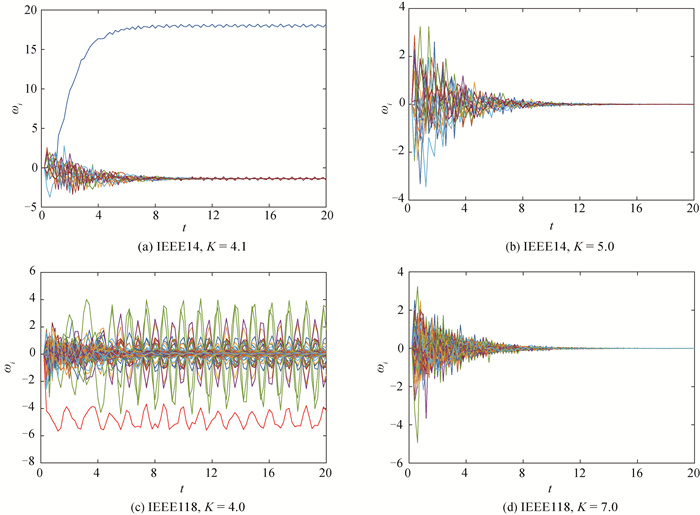
图1 IEEE标准测试系统的网络频偏随演化时间变化(a)、(c) IEEE14和IEEE118系统的网络频偏向高频振荡和低频振荡两个集群进行发散;(b)、(d) IEEE14和IEEE118系统的网络频偏向标准工作频率进行汇聚
Fig.1 Frequency offset varies with evolution time in IEEE standard test systems (a) and (c) Divergence of frequency offset towards two clusters at high and low oscillating frequencies before network synchronization in IEEE14 and IEEE118 systems; (b) and (d) Convergence of frequency offset towards common frequency in IEEE14 and IEEE118 systems

图2 EEE标准测试网络拓扑结构 (品红色三角形表示发电机节点, 蓝色圆形表示负载节点。)(a) IEEE14标准测试网络; (b) IEEE57标准测试网络
Fig.2 Topology of IEEE standard test systems (Pink triangles denote generators. Blue circles denote consumers.)(a) IEEE14 standard test system; (b) IEEE57 standard test system
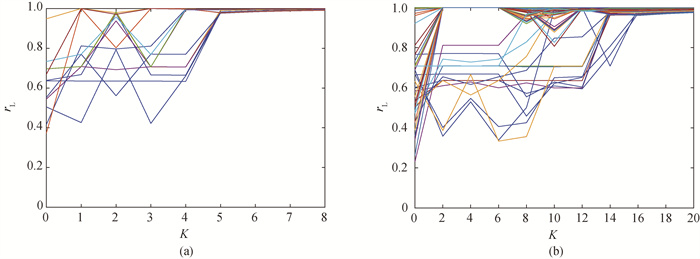
图3 局部平均序参数随耦合强度的变化 (蓝色粗线代表发电机节点, 其它颜色折线代表负载节点。)(a) IEEE14标准测试网络; (b) IEEE57标准测试网络
Fig.3 Local order parameter varies with coupling strength (The blue and bold lines represent the generator nodes. Other lines represent the load nodes.)(a) IEEE14 standard test system; (b) IEEE57 standard test system
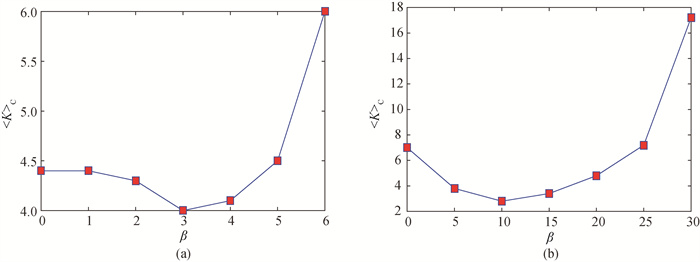
图4 网络的临界同步耦合强度均值随线路耦合强度离散率的变化(a) IEEE14标准测试网络; (b) IEEE118标准测试网络
Fig.4 Critical synchronous coupling strength varies with line coupling strength dispersion rate in IEEE systems (a) IEEE14 standard test system; (b) IEEE118 standard test system
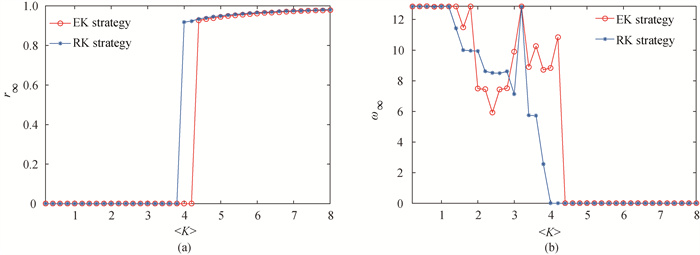
图5 IEEE14节点系统(a)稳态序参数, (b)平均频偏随平均耦合强度的变化
Fig.5 (a) Steady-state order parameter and (b) average frequency offset vary with average coupling strength in an IEEE14 system
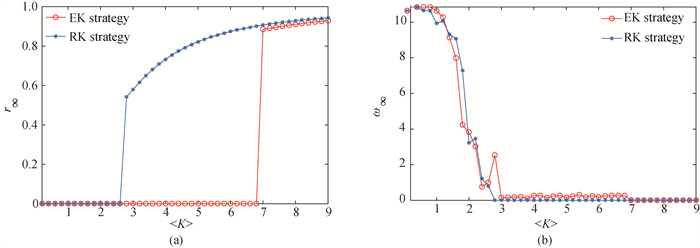
图6 IEEE118节点系统(a)稳态序参数, (b)平均频偏随平均耦合强度的变化
Fig.6 (a) Steady-state order parameter and (b) average frequency offset vary with average coupling strength in an IEEE118 system
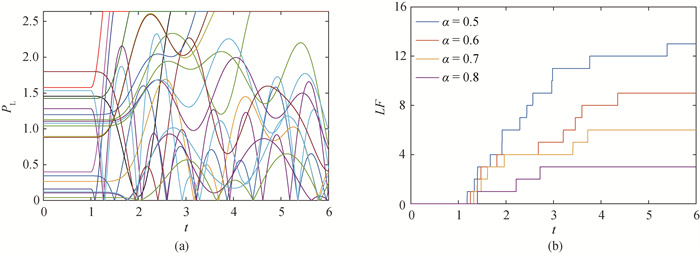
图7 IEEE14节点系统(a)各线路的传输功率, (b)失效连边总数随演化时间的变化
Fig.7 (a) Transmission power of each line and (b) number of failed lines vary with evolution time in IEEE14 system
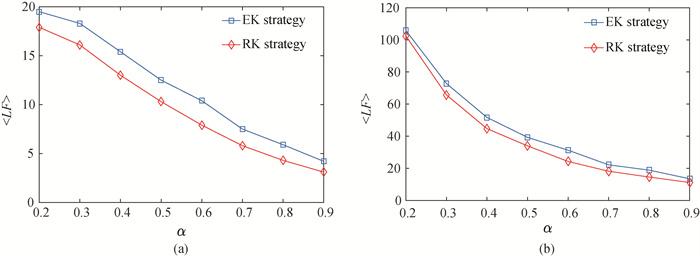
图8 IEEE网络中平均失效线路总数随容量控制参数的变化(a) IEEE14标准测试网络; (b) IEEE118标准测试网络
Fig.8 Average number of failed lines varies with control parameter in IEEE systems (a) IEEE14 standard test system; (b) IEEE118 standard test system
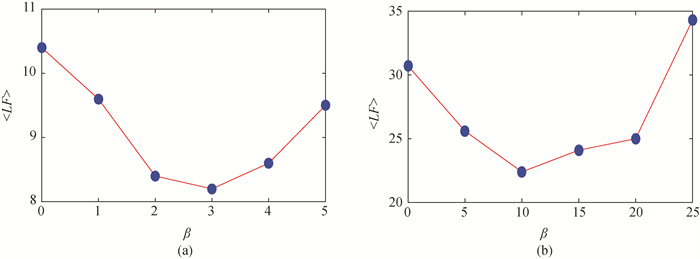
图9 IEEE网络中平均失效线路总数随线路耦合强度离散率的变化(a) IEEE14标准测试网络; (b) IEEE118标准测试网络
Fig.9 Average number of failed lines varies with line coupling strength dispersion rate in IEEE systems (a) IEEE14 standard test system; (b) IEEE118 standard test system
| 1 |
DOI |
| 2 |
DOI |
| 3 |
DOI |
| 4 |
汪小帆, 李翔, 陈关荣. 复杂网络理论及其应用[M]. 北京: 清华大学出版社, 2006.
|
| 5 |
|
| 6 |
孔江涛, 黄健, 龚建兴, 等. 基于复杂网络动力学模型的无向加权网络节点重要性评估[J]. 物理学报, 2018, 67 (9): 98901- 098901.
|
| 7 |
DOI |
| 8 |
|
| 9 |
DOI |
| 10 |
胡钋, 李莉莉, 张宝丹, 等. 智能电网中交互级联故障传播的影响因素分析[J]. 智慧电力, 2021, 49 (5): 69- 76.
DOI |
| 11 |
DOI |
| 12 |
王宇飞, 李俊娥, 刘艳丽, 等. 容忍阶段性故障的协同网络攻击引发电网级联故障预警方法[J]. 电力系统自动化, 2021, 45 (3): 24- 32.
|
| 13 |
|
| 14 |
DOI |
| 15 |
|
| 16 |
DOI |
| 17 |
|
| 18 |
DOI |
| 19 |
DOI |
| 20 |
刘文霞, 黄钰辰, 万海洋, 等. 复杂网络理论在能源互联网脆弱性与鲁棒性研究中的应用[J]. 智慧电力, 2021, 49 (1): 14- 21.
DOI |
| 21 |
傅杰, 邹艳丽, 谢蓉. 基于复杂网络理论的电力网络关键线路识别[J]. 复杂系统与复杂性科学, 2017, 14 (3): 91- 96.
|
| 22 |
DOI |
| 23 |
|
| 24 |
DOI |
| 25 |
|
| 26 |
DOI |
| 27 |
DOI |
| 28 |
|
| [1] | 刘凯歌, 韦笃取. 基于WOA-ESN的电机系统混沌振荡预测[J]. 计算物理, 2022, 39(4): 498-504. |
| [2] | 张少泽, 邹艳丽, 谭秫毅, 李浩乾, 刘欣妍. 基于复杂网络理论的互联电网Braess悖论现象分析[J]. 计算物理, 2022, 39(2): 233-243. |
| [3] | 邹艳丽, 高正, 梁明月, 李志慧, 何铭. 基于潮流追踪的电网同步性能优化及鲁棒性分析[J]. 计算物理, 2020, 37(5): 623-630. |
| [4] | 石建平, 李培生, 刘国平. 基于改进克隆选择算法的统一混沌系统同步控制与参数辨识[J]. 计算物理, 2020, 37(2): 240-252. |
| [5] | 钟国翔, 韦笃取, 张波. 分布式发电系统感性负载的远程混沌同步[J]. 计算物理, 2019, 36(6): 719-725. |
| [6] | 邹艳丽, 王瑞瑞, 吴凌杰, 姚飞, 汪洋. 基于局部序参数的电网同步性能优化[J]. 计算物理, 2019, 36(4): 498-504. |
| [7] | 石建平, 杨兰天, 刘丹. 基于量子粒子群算法的混沌系统同步控制及参数辨识[J]. 计算物理, 2019, 36(2): 236-244. |
| [8] | 查进道, 李春彪. 基于引力场理论的混沌同步[J]. 计算物理, 2018, 35(6): 737-749. |
| [9] | 刘利花, 韦笃取, 张波. 基于动力中继的小世界复杂电机网络混沌同步控制[J]. 计算物理, 2018, 35(6): 750-756. |
| [10] | 王意, 邹艳丽, 黄李, 李可. 综合考虑局部和全局特性的电网关键节点识别[J]. 计算物理, 2018, 35(1): 119-126. |
| [11] | 钱慧, 于洪洁. SC混沌比例投影同步方法在保密通信中的应用[J]. 计算物理, 2016, 33(1): 117-126. |
| [12] | 蓝庆玉, 邹艳丽, 冯聪. 电网在三种边攻击方式下的级联失效[J]. 计算物理, 2012, 29(6): 943-948. |
| [13] | 孟娟, 王兴元. 一类延迟混沌神经网络的鲁棒反同步[J]. 计算物理, 2008, 25(2): 247-252. |
| [14] | 冯秀琴, 沈柯. 利用超混沌信号调制参数实现简并光学参量振荡器混沌同步[J]. 计算物理, 2007, 24(6): 677-682. |
| [15] | 于洪洁, 彭建华. 非线性耦合超混沌Rössler系统和网络的同步[J]. 计算物理, 2006, 23(5): 626-630. |
| 阅读次数 | ||||||
|
全文 |
|
|||||
|
摘要 |
|
|||||
版权所有 © 《计算物理》编辑部
地址:北京市海淀区丰豪东路2号 邮编:100094 E-mail:jswl@iapcm.ac.cn
本系统由北京玛格泰克科技发展有限公司设计开发
